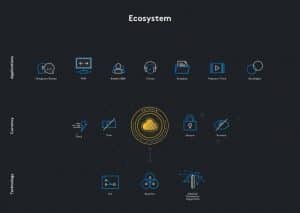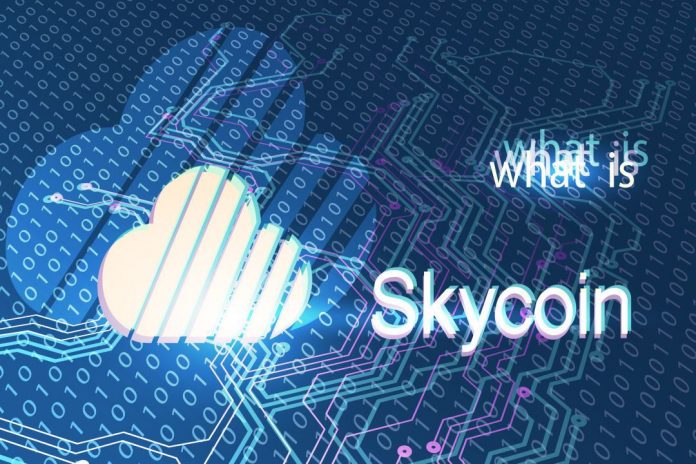Skycoin is not just a cryptocurrency, but a full-fledged ecosystem whose development began 8 years ago. Its objective is to provide a truly decentralised network infrastructure in which all users can benefit from the Skycoin blockchain.
Skycoin aims to provide a total decentralisation of the network by exploiting its consensus algorithm – Obelisk – and eliminating the concept of mining for the production of coins.
Skycoin, in fact, is not only a cryptocurrency but a platform consisting of a series of solutions aimed at solving the main problems of today’s blockchain technology (scalability, speed, privacy and fees).
Details and origins of Skycoin
Skycoin was born in 2013, that’s when the first commit on the GitHub repository was made. However, the project idea was born about 8 years ago, shortly after the birth of bitcoin, with the aim of remedying the shortcomings of BTC and offering a real decentralised cryptocurrency.
At the time, in fact, the effects of mining were already being felt, with all its negative consequences. Enormous mining pools were being created, most of them located in China, and the first mining farms were born, also located in a few areas of the world.
Subsequently, the first ASICs also arrived, almost all of which were produced by the same manufacturer. Mining therefore became a race for profit and not for the maintenance of the network, as well as a threat to the decentralisation of the network, given that at the time ASICs and Mining pools were concentrated mainly in China.
SkyCoin’s team, made up of some of the first developers of Bitcoin and Ethereum, decided to create a truly decentralised, fast, scalable system without the problems resulting from mining.
However, alongside these problems, the issue of net neutrality also emerged. Internet Service Providers (ISPs), in fact, have – sadly – the ability to limit the quality of Internet services to users but above all can sell customer data to third party services.
To achieve total decentralisation, Skycoin had to address both the issue of PoW and net neutrality, developing its own consensus algorithm – Obelisk -, its own mesh network – Skywire -, its own scalable blockchain network – Fiber – and its own hardware network, ie the Skyminers.
Features of Skycoin
Speed and throughput
First of all, the network is able to guarantee a high number of transactions per second, ranging from 300 to 3000 TPS depending on the implementation. However, the Fiber platform should theoretically be infinitely scalable. And of course, the confirmation times are also short: it only takes a few seconds.
Feeless
Another even more interesting aspect concerns the fees, which are practically zero. In reality, carrying out Skycoin transactions is not free but costs fractions of Coin Hour, a currency used to pay fees and which is generated by holding Skycoin the wallet for one hour. So it can be said that the fees are zero, since the Coin Hour are generated and distributed to users who own Skycoin every hour.
Privacy and security
Two other key features relate to user privacy and network security. To guarantee the privacy and therefore the anonymity of the transactions, a system involving the mixing and merging of the transactions (CoinJoin) is used, making them indistinguishable from each other and therefore impossible to trace back to the sender.
On the security front, Skycoin should be immune to 51% attacks, given the absence of miners and stakers. As in other cryptocurrencies, the classic and consolidated cryptographic standards are used.
Sustainability, incentives and countervalue
By not using any PoW algorithm, the network doesn’t need miners and therefore doesn’t require a huge amount of computational power and energy. Network nodes, in fact, use energy-efficient and low-power hardware, such as Raspberry Pi and ARM solutions.
Mesh network node holders also receive incentives. Finally, the value of Skycoin is associated with a real asset, namely the network bandwidth.
The Obelisk consensus algorithm
The centrepiece of Skycoin is Obelisk, the distributed consensus algorithm developed by the team. Obelisk uses a web-of-trust mechanism (i.e. a network of trust) to distribute to nodes the ability to influence the network. As there are no miners, the network consists of a series of nodes, such as computers, smartphones and Skyminers. Each node is in turn linked to other nodes, selected from a list of reliable nodes.
Nodes with more interconnections have a greater capacity to influence the network. Each node has a personal blockchain that acts as a broadcasting channel, in which every action taken by the node is recorded and made publicly visible.
Since all decisions and communications are made via the personal blockchain, the community and other nodes can easily control – without compromising privacy – the behaviour of the nodes, so as to check whether they operate correctly. Each node has its own public key and IP address, the latter known only to nodes directly connected to it.
When one node acts in a malicious way, the other nodes can disconnect, drastically lowering the consensus power and therefore the influence within the network. This way there is a dynamic and real-time control of the network.

Obelisk should thus guarantee:
– High scalability and low power consumption
A high scalability is achieved thanks to a consensus algorithm designed to be scalable over a wide network of nodes. Moreover, since it does not use the classic PoW mechanisms, the creation of blocks can be performed on low-end hardware, and therefore not very energy-intensive. As the network grows, centralisation decreases, making the network completely decentralised.
– Resistance to attacks
Obelisk is able to withstand large scale combined attacks. Not being iterative, it can also work on a network of scattered nodes, connected only to adjacent nodes. It is also immune to 51% attacks as the web-of-trust mechanism prevents the development of centralised power. Since there is no miner or staker, the network is not affected by the vulnerabilities of PoW and PoS. Moreover, the public personal blockchain of each node, allows the rapid identification of incorrect nodes and the consequent removal from the network.
– Hidden IP addresses
Nodes are only routed using their own public key. The IP address of each node, in fact, is known only to the nodes connected to it.
Skywire
Skywire is perhaps the most innovative and ambitious aspect of the Skycoin project. One of the objectives of the Skycoin team is to ensure net neutrality, so that the network cannot be controlled by third-party ISPs and entities. Skywire was developed for this purpose, a truly decentralised Internet network based on mesh networks. Being decentralised, it is obviously controlled by the users.
Skywire Protocol
To work, Skywire needs an ad-hoc protocol for mesh networks, because the classic TCP/IP does not scale optimally on this network topology. Multi-Protocol Label Switching (MPLS) is therefore used to maximise scalability and performance while minimising latency. With MPLS, routes through the network are determined before traffic is sent. A header describing their path over the network is then attached to packets coming out of a node.
This way, when a node receives the packet, it simply reads that header and performs the necessary operations. This mechanism is lighter and more powerful than the classic IP routing.
Skywire’s communication protocol also provides privacy and security, as each node only knows the previous and next node of the package. In other words, it does not know the sender or the recipient.
Furthermore, the nodes on the Skywire network are uniquely identified by the hash of the public key instead of the IP address. This makes man-in-the-middle attacks impossible, since a source node can verify the authenticity of the destination through the public key.
Finally, all traffic carried within the Skywire network is encrypted end-to-end, so that intermediary nodes cannot know or intercept the traffic.
The benefits of Skywire
By harnessing hundreds of thousands of network nodes, Skywire can ensure a distributed, fast, redundant and efficient network. Skywire supports channel bonding to offer the right mix of speed and reliability. In addition, the ability to connect to multiple nodes at the same time dramatically increases productivity and redundancy.
Since everything is encrypted, the system is able to ensure that all traffic remains private, thus maintaining the privacy of users. Given the topology of the network, the consensus mechanism of the nodes and the use of public keys to route the nodes themselves, the level of security guaranteed should be high, since it is also immune to the classic attacks already seen on other networks.
Insofar as the network nodes will be made up of the actual community, incentives will be offered in the form of Coin Hour or Skycoins for users that contribute to the network. The performance of the network will be dependent on the community. Thanks to the services offered, it will also create a real economy within the network.
The Fiber platform
Fiber is the actual blockchain of the Skycoin ecosystem. Skycoin’s Fiber architecture allows, at least on paper, to solve the main problems of the current blockchains. Fiber, in fact, should technically be infinitely scalable, and can be described as a series of parallel blockchains, like the threads of a fabric (hence the name fiber).
Currently, Bitcoin can handle about 7-10 transactions per second (TPS), while Ethereum can handle about 25 TPS. Depending on the implementation and the number of nodes, Fiber can scale from 300 to 3000 TPS.
Moreover, compared to the Bitcoin core, the Fiber protocol is more optimised and lighter, considering that there are about 5000 lines of code compared to the almost 100 thousand lines of Bitcoin.
The parallel blockchains approach adopted by Fiber, in addition to offering better throughput, also allows to guarantee a certain interoperability (Atomic Swap) between the blockchains themselves.
Each blockchain that is added to the network strengthens the network and improves its scalability instead of worsening it. Moreover, the architecture is highly customisable to meet specific needs.
CXO, CX and the Skycoin ecosystem
On the Skycoin network, particularly on Fiber and Skywire, developers will be able to create their own distributed applications (dApps), using CX and CXO.
CXO (CX Object Systems) is a real system of immutable objects. It is designed to replace the current conventional peer-to-peer sharing methods, such as BitTorrent, but also Dropbox and Google Drive.
The data is in fact replicated on the nodes of the Skywire network using the Skycoin CXO library. CXO incorporates and expands protocols used in other storage networks based on blockchain technology (IPFS), but provides the ability to distribute data securely and immutably on the Skywire network without the need to use blockchain for storage.

Using the CX programming language it will be possible to create applications to be used on the Skycoin ecosystem. For example, it will be possible to create VPN services, decentralised messaging applications, streaming media services and much more. All this using the Coin Hour or Skycoin currency to make payments within the network.
The Skyminers
Skycoin is not only software but also hardware. It is one of the very few projects that also includes a hardware part for the development of its Skywire network. SkyMiners are simple calculation units that act as network nodes for the Skywire network. Although the name miner suggests that they are cryptocurrency mining machines, in reality they are the backbone of the network.
The hardware used consists of eight Orange Pi, all connected to a router and with their own pre-configured software to make the Skyminer act as a specialised VPN node.
The technical specifications of the first Skyminer, produced and marketed in recent months, provide:
- eight Orange Pi with custom PCB;
- a 16-port router with OpenWRT OS;
- 16GB RAM (32 x 512MB DDR3), 2GB per card;
- ARM Cortex-A53 architecture;
- 8 x 16-32 or 64GB Micro SD class 10 A1;
- Hexa-core Mali450 GPU for each card;
- Quad-core CPU for each card;
- 100Mbps Ethernet LAN port for each card;
- an 8+1-port Gigabit Ethernet switch;
- 64-bit Linux operating system (Alpine Linux).

More models will be available in the future, probably even cheaper.
The owners of the Skyminer nodes will receive, once the Skywire network is activated, Skycoin coins as incentives and compensation, as well as a certain amount of Coin Hour based on the amount of bandwidth shared on the Skywire network.
The Skycoin team also stated that they are working on the development of short (5Km) and long (15Km) range antennas and telecommunications systems, so as to build a full-fledged mesh network over time that is partially independent of the current layer.
Supply and Coin Hour
The total supply amounts to 100 million Skycoins, but 75% of them will remain blocked until the threshold of 25 million Skycoins in circulation is reached. There are currently approximately 15 million SKY in circulation. A relatively low number of tokens.
With regard to Coin Hour, as mentioned above, each transaction consumes Coin Hour tokens, which are then burned. Coin Hour can be earned simply by owning Skycoin. If the users hold Skycoin in the wallet, they’ll get a Coin Hour every hour. The ratio is 1 to 1. In addition to paying the costs of transition and eliminating any problem of spam on the network, Coin Hour are used for the operation of CoinJoin and therefore the maintenance of privacy.
Through CoinJoin transactions are combined with each other, thus becoming indistinguishable and guaranteeing the privacy of users. Coin Hour can also be used to purchase bandwidth on the Skywire platform and other services.
Coin Hour aren’t infinite. Only 100 million coins are produced every hour. This is to ensure the correct use of the network and to prevent inflation. Finally, each transaction destroys 50% of the Coin Hour costs to pay the network fees.
The exchanges where to buy it
Currently, Skycoins can be purchased on various exchanges, including Binance.



